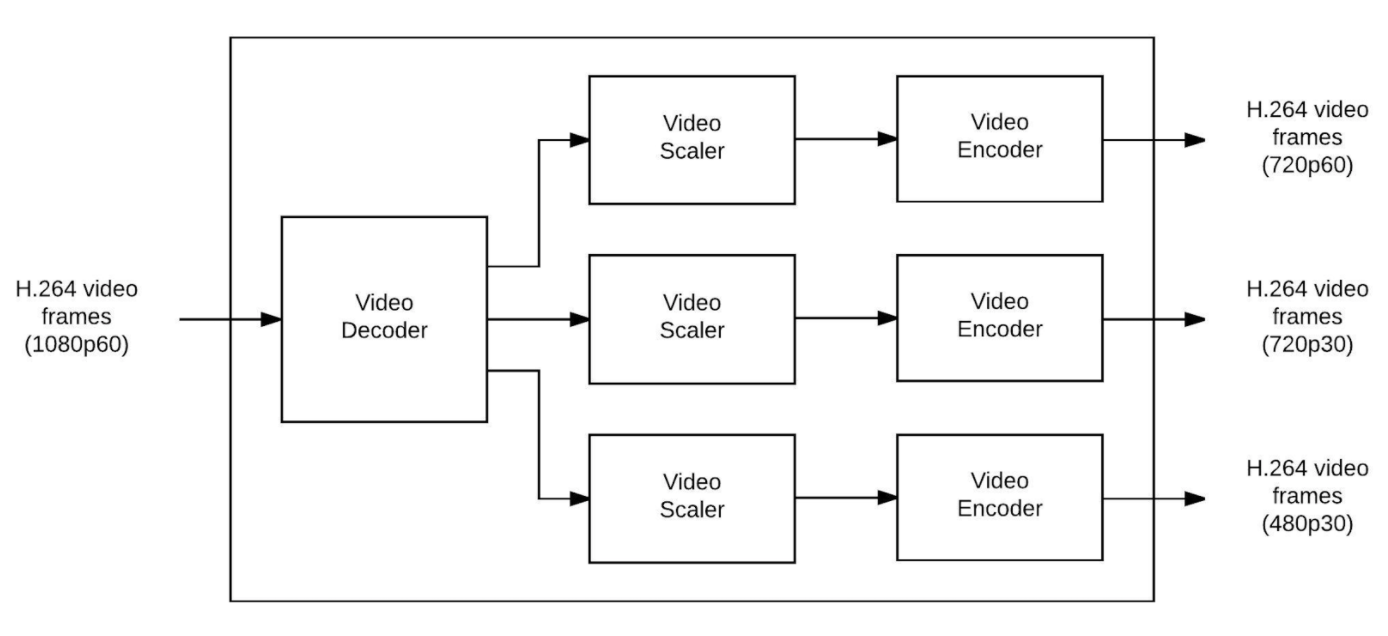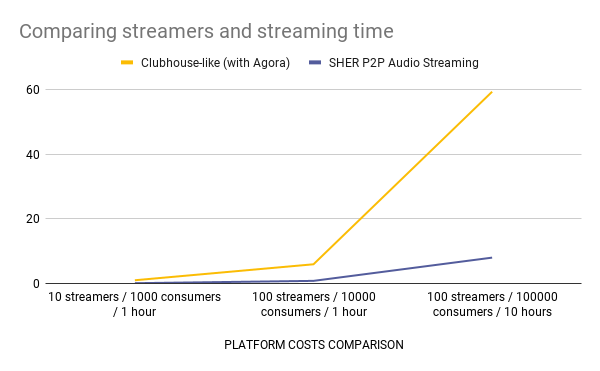Discover how we can change the creators economy with P2P Live Streaming.
Unfair Advantage with P2P Streaming
What would you say if someone pitched you an idea that works 95% more efficiently than the competition? What if it even had a green side effect?.
This is usually known as a product with a clear unfair advantage over its competitors. And we have found that unfair advantage for content streaming platforms.
What can we do with an unfair advantage on a live streaming platform?
The answer is simple: Higher payouts for creators!
Having the best payouts in the market could help us attract the best streamers and more attention on our platform.
How? With lower platform costs. Way way lower.
Let's think about live streaming and its infrastructure. That's our business, we are building a live media platform at sher.app, starting with live audio streaming (eg: shows & conversations).
To better understand this situation, let's see how a streaming platform works nowadays. Let's focus first on a video streaming platform since it's one of the most popular mediums today. Audio-only streaming platforms are similar but with less CPU requirements. We will consider them later too.
There are 3 main things a live streaming platform does:
- Ingesting
- Transcoding
- Delivery
1 is hardly CPU intensive, with a direct correlation between bandwidth/streamers.
2 is highly CPU intensive.
3 is all about bandwidth costs and moving data to the edges (i.e: being as close as possible to the consumers).
Let's dig into the live streaming process. This is what happens when you go live on a traditional streaming platform:
Bob goes live. Bob's video/audio data goes to the streaming platform's ingesting servers (1). Ingesting is the process of receiving the data efficiently, storing it and preparing everything for transcoding. As you can imagine this involves keeping open a data streaming flow and some parsing. Data reception involves low to medium CPU work to constantly evaluate what you are receiving.
As data is ingested it goes in chunks to the next phase, transcoding (2). This phase is all about preparing Bob's video/audio to be consumed by different devices, see figure 1. It's not the same video/audio quality/format that goes to a desktop computer than what is sent to a mobile device (this usually goes from 480p to 1080p). Converting video for different devices/conditions involves lots of calculation, hence high CPU usage and then high energy consumption.

Figure 1. Transcoding Process (Ref)
The next step in this streaming assembly line is delivery (3). This involves bandwidth costs. Moving data that is ready to be consumed from the encoding servers to Bob's audience. In order to comply with global access, Bob's streaming platform uses edge servers to cache content. This basically means that some computers distributed around the world receive the content ready to be consumed. Bob's audience interacts with these edge servers.
All these tasks take place almost simultaneously and the end goal is deliver the content with the lowest latency possible.
On September 21, Twitch President Dan Clancy sent a letter directed to all their streamers partners. It was to inform them about some changes with the streamers’ earnings. Now, twitch is going to take the 50% cut instead of the 30% (for creators with a revenue above USD 100K). This is causing a lot of controversy within their community since it has a huge impact.
One of the main arguments behind this decision is that platform service costs are high. In the letter, they mention that running the whole service for 1 creator with more than 100 concurrent viewers, streaming 200 hours over a month, costs more than 1000 USD/month.
Applying Some P2P Leverage 🕹
With Peer-to-peer technology we can achieve this unfair advantage, leading to higher payouts for creators, without impacting the audience's pockets. It's a win/win situation.
At SHER we are working hard to make this a reality. Based on our estimations we can provide payouts above 80%. Best in market. See table 1 below.
| Twitch | Youtube | SHER | |
|---|---|---|---|
| Subscriptions Values $ | $4.99 | $4.99 | $3.99 |
| Platform Cut | 50% | 30% | 17% - 12% |
| Creators Earnings (per subscription) | $ 2.4 | $ 3.4 | $ 3.3 |
| Requirement |
|
|
Comply with ethics code |
But, how? The way twitch & other platforms handle live streaming is pretty standard.
Let's Introduce P2P Streaming
This is how it works. Every time a new streamer goes live on SHER, they create their own streaming network. As soon as the audience starts to join, every new listener will do two things, listen to the show (consume it) and re-share it with others, helping the streamer spread the word.
This happens ad hoc and on demand for every show, we call this effect the “show network”. Streaming data goes from the streamer to the audience and they reshare the message with other fans. There are no centralized streaming servers, nor ingesting servers involved. No install required. Simple & direct.
This approach is radically different. We have been beta testing it since February and it's working really well.
P2P streaming is a new alternative over traditional platforms. It works with significantly lower platform costs, relying more on the network of fans around a show. Traditional platforms require ingesting servers, transcoding servers & edge delivery servers. All of this with redundancy and with an ops team behind it 24/7. On the other hand, P2P streaming is all about connecting peers. Quickly & efficiently. Take a look at table 2 for a comparison between different streaming solutions and SHER P2P streaming.
If we only focus on audio streaming platforms alone, SHER is 150% more efficient than the current state of art.
| PLATFORM COSTS COMPARISON (usd/month) | Twitch-like Video Streaming (with Amazon IVS) | Clubhouse-like Audio Streaming (with Agora) | SHER P2P Audio Streaming |
|---|---|---|---|
| 10 streamers / 1000 consumers / 1 hour | $ 115 | $ 0.99 | $ 0.08 |
| 100 streamers / 10000 consumers / 1 hour | $ 1150 | $ 5.94 | $ 0.8 |
| 100 streamers / 100000 consumers / 10 hours | $ 75000 | $ 59.40 | $ 8 |
The main difference is that P2P streaming scales very well with low and stable infrastructure curves. In figure 2 we compare one popular audio streaming solution with SHER. We'd like to continue our video research so we can show you a full comparison with audio and video live streaming.
We believe this is a game changer for creators' economies.

With P2P streaming we basically have more options, more flexibility. We can offer better margins for creators. This is massive.
There is also a great narrative we can add on top of this new distribution model. Seeding benefits for the audience who will share their favorite shows is a good example. One of our main goals is to be resource efficient and re-use engagement time. This is, while you are consuming your favorite streamer, you are also resharing and helping to “spread the word”, all of this without impacting on your experience.
Audio listening & resharing does not require lots of computer power. We've tested it with a significant number of different devices and OSs.
Another benefit of P2P streaming is dramatically reducing the ads pressure. Since platform service costs are way less than competitors, we don't have the need to aggressively jump onto the advertising boat.
This is quite common nowadays, you as a consumer have seen it countless times. Every platform is figuring out ways to basically show more ads. Twitch is a good example, where it is becoming more and more common to see things like 5 ads in a row.
Most of the time streamers don't have control over those ads. This is important because creators' game is all about building the best relationship possible with their audience. If we add more ads “in-show”, we should give at least some options or voice in what to display (eg: brands/products).
For the VC angle, another reading for the unfair advantage statement, is that this gives us a potentially longer runway. Hence more options to try and a more resilient startup model. At SHER we take operations very seriously. We understand the “startup game” and we know there are many scenarios where we could fail, but we also recognize we have some really solid reasons in our favor too.
Final Thoughts
All in all, P2P streaming represents a new way for efficiently scaling creator based platforms. Using a P2P stack represents an unfair advantage when it comes to streaming costs and platform service costs. This has such a direct impact that it permits a platform like ours to offer a better deal for creators (tentative payouts above 80%) and their fans (lower subscription prices, less/no ads). It also has the potential to give us a longer runway and more flexibility options.
These are just some of the direct benefits of our approach. There are others we'd like to explore like going further into the environmental benefits of P2P streaming. P2P systems are likely to consume less energy than central solutions (see S. Nedevschi, S. Ratnasamy, and J. Padhye, “Hot Data Centers vs. Cool Peers”).
Finally, imagine being able to add video live streaming too on top of this combo? It's a game changer.
That's it! Time to go back and continue with our journey, building the best solutions for creators and their fans.
Acknowledgments
This article has been reviewed by two phenomenal P2P engineers and friends, they are: Mauve & Julian Gruber.
Thank you very much for your thoughtful feedback!
If any of this sounds interesting, just drop me a line:
diego at sher.app
Charlemos! Extra points for latinxs investors.
